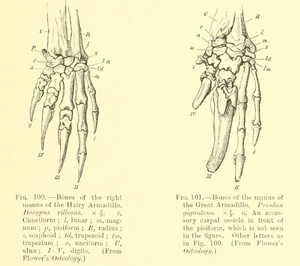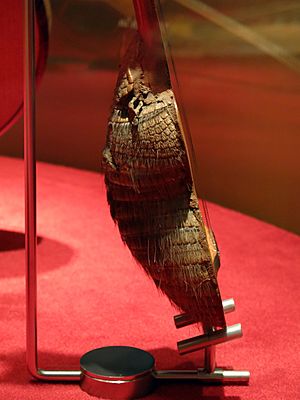Armadillo facts for kids
Quick facts for kids Armadillos |
|
|---|---|
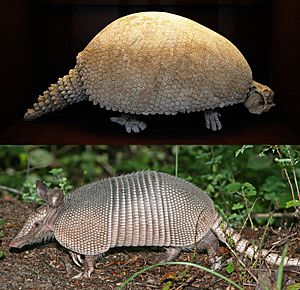 |
|
| Glyptodon (Natural History Museum, Vienna) and Dasypus novemcinctus | |
| Scientific classification |
|
| Kingdom: | Animalia |
| Phylum: | Chordata |
| Class: | Mammalia |
| Superorder: | Xenarthra |
| Order: | Cingulata |
| Families | |
|
Chlamyphoridae |
|
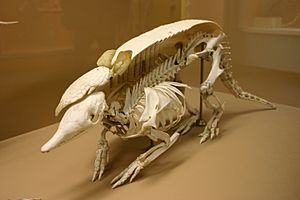
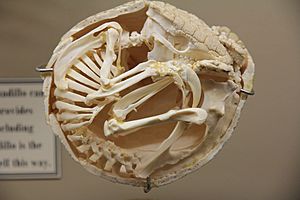
Armadillos are fascinating mammals known for their unique, tough armor. Their name means "little armored ones" in Spanish. These amazing creatures are found only in the Americas, living in many different environments. They are related to anteaters and sloths, all belonging to a group called Xenarthra.
There are 21 different types, or species, of armadillos alive today, and many more that are now extinct. Some are known by how many bands they have on their armor. Armadillos have a leathery shell and strong, sharp claws perfect for digging. They have short legs but can move surprisingly fast!
Most armadillos are about 75 centimeters (30 inches) long, including their tail. The giant armadillo is the biggest, growing up to 150 centimeters (59 inches) and weighing up to 54 kilograms (119 pounds). The smallest is the pink fairy armadillo, which is only about 13 to 15 centimeters (5 to 6 inches) long. When some armadillos, like the three-banded species, feel threatened, they can roll up into a tight ball to protect themselves. They are the only armadillos that can do this!
Contents
What's in a Name?
The word armadillo comes from Spanish and means "little armored one." It's based on the word "armadura," which means armor.
Long ago, the Aztecs in Mexico called them āyōtōchtli, which means "turtle-rabbit." This name describes them well, as they look a bit like a turtle with their shell and a rabbit with their ears! In Portuguese, the word for armadillo is tatu, which comes from a native language meaning "bark" or "armor" and "dense."
Armadillos have many other names depending on where you are:
- quirquincho in countries like Argentina and Bolivia
- cuzuco in Central American countries like Costa Rica and Honduras
- mulita in Argentina and Uruguay
- peludo in Argentina, Chile, and Uruguay
- piche in Argentina, Brazil, and Chile
- cachicamo in Colombia and Venezuela
- carachupa in Peru
Armadillo History
Armadillos first appeared in South America. For a long time, they stayed only on that continent because it was separated from others. But when the land bridge called the Isthmus of Panama formed, some armadillos were able to travel north into North America. This was part of a big animal exchange between the continents.
Today, you can still find all kinds of armadillos in South America. Paraguay, for example, has 11 different species! Many armadillo species are in danger of disappearing. Some, like the nine-banded armadillo, are found in many places across the Americas. Others, like Yepes's mulita, live only in small areas.
The nine-banded armadillo has even made its way into the United States, especially in southern states like Texas and Florida. Their range has been growing steadily northward over the last 100 years, partly due to climate change.
Who Hunts Armadillos?
Armadillos don't have many natural enemies. Wolves, bears, wildcats, and coyotes might hunt them. However, the biggest danger to armadillos comes from humans.
Many armadillos, especially the nine-banded kind, are hit by cars. This is because when they get scared, they often jump straight up into the air. This makes them hit the underside of vehicles, which can be very dangerous for them.
Amazing Armadillo Features
Armadillo Size
The smallest armadillo is the pink fairy armadillo. It weighs only about 85 grams (3 ounces) and is 13 to 15 centimeters (5 to 6 inches) long. The largest is the giant armadillo, which can weigh up to 54 kilograms (119 pounds) and be 150 centimeters (59 inches) long.
What Armadillos Eat
Armadillos eat different things, but mostly they enjoy insects, grubs, and other small creatures without backbones. Some species eat almost only ants and termites.
Armadillos are excellent diggers! They use their sharp claws to dig for food and to make their homes, called burrows. The nine-banded armadillo likes to dig burrows in wet soil near creeks and streams.
Armadillos have very poor eyesight. Instead, they use their amazing sense of smell to find food. They dig their burrows with their claws, making a single tunnel just wide enough for their body. They have five clawed toes on their back feet and three to five strong digging claws on their front feet. Armadillos have many small teeth, but usually no front teeth or canine teeth.
Body Temperature
Armadillos generally have lower body temperatures than most mammals, usually between 33 and 36 degrees Celsius (91 to 97 degrees Fahrenheit). This is especially true for armadillos that mostly eat termites.
Armadillo Skin and Armor
An armadillo's armor is made of bony plates under its skin. These plates are covered with small, overlapping scales made of keratin, the same material as your fingernails. Most armadillos have stiff shields over their shoulders and hips. Between these shields, they have several bands of flexible skin that cover their back and sides. More armor covers their head, the tops of their legs, and their tail.
The underside of an armadillo is soft and covered with fur, not armor. This armor helps protect them, but most armadillos escape predators by running away or digging into the ground. Only the South American three-banded armadillos rely heavily on their armor by rolling into a ball.
How Armadillos Defend Themselves
When a three-banded armadillo feels threatened, it rolls up into a tight ball. Other armadillo species can't do this because their armor plates are too numerous or too stiff. The North American nine-banded armadillo tends to jump straight up when surprised. This can be dangerous for them if a car is passing by.
How Armadillos Move
Even though armadillos have short legs, they can move quite fast! The nine-banded armadillo is also known for how it moves through water. It can walk underwater for short distances, holding its breath for up to six minutes. To cross bigger bodies of water, it can swallow air to make its stomach and intestines inflate, helping it float!
Armadillo Reproduction
Armadillo babies are born after about 60 to 120 days, depending on the species. However, the nine-banded armadillo has a special ability called "delayed implantation." This means the baby might not be born until eight months after mating.
Most nine-banded armadillos give birth to four identical babies at once. Other species might have one to eight babies in a litter. The young are born with soft, leathery skin that becomes hard within a few weeks. They become adults in three to twelve months. Armadillos are usually solitary animals and don't share their burrows with other adults.
Armadillos and People
Science and Education
Armadillos are very important in the study of leprosy, a disease that affects the skin and nerves. This is because armadillos are one of the few animals that can get leprosy, similar to how humans do. They are especially good for studying leprosy because their body temperature is a bit lower than most mammals, which is perfect for the leprosy bacteria to grow.
Scientists believe that humans can get leprosy from armadillos by touching them or eating their meat. Before Europeans came to the Americas, leprosy was not known there. So, armadillos likely caught the disease from humans who came from other parts of the world.
Armadillos are also important for studying Chagas disease, another illness.
The nine-banded armadillo is also special because of how it reproduces. It always gives birth to four genetically identical babies from one egg. Because these four babies are exactly alike, they are very useful for scientific studies that need subjects with the same biological and genetic makeup. This is a rare trait in mammals and only happens in the Dasypus group of armadillos.
Armadillos in Culture
In some parts of the Andes mountains, armadillo shells were traditionally used to make the back of a musical instrument called a charango. Today, most charangos are made from wood.
In Central and South America, some people eat armadillo meat. During the Great Depression in the United States, some Americans ate armadillos and jokingly called them "Hoover hogs," referring to President Herbert Hoover.
Armadillos have also appeared in books and songs! Rudyard Kipling wrote a fun story called The Beginning of the Armadillos in his Just So Stories children's book. There's also a humorous song called "The Armadillo" by Flanders and Swann. Poet Shel Silverstein even wrote a short poem about bathing an armadillo!
See also
 In Spanish: Armadillos para niños
In Spanish: Armadillos para niños
- Armadillo shoe
- Echidnas, another type of mammal with a spiky body covering
- Hedgehogs, another mammal group with spiky body coverings
- Pangolins, another mammal group with scaly body coverings
- Porcupines, another mammal group with spiky body coverings



